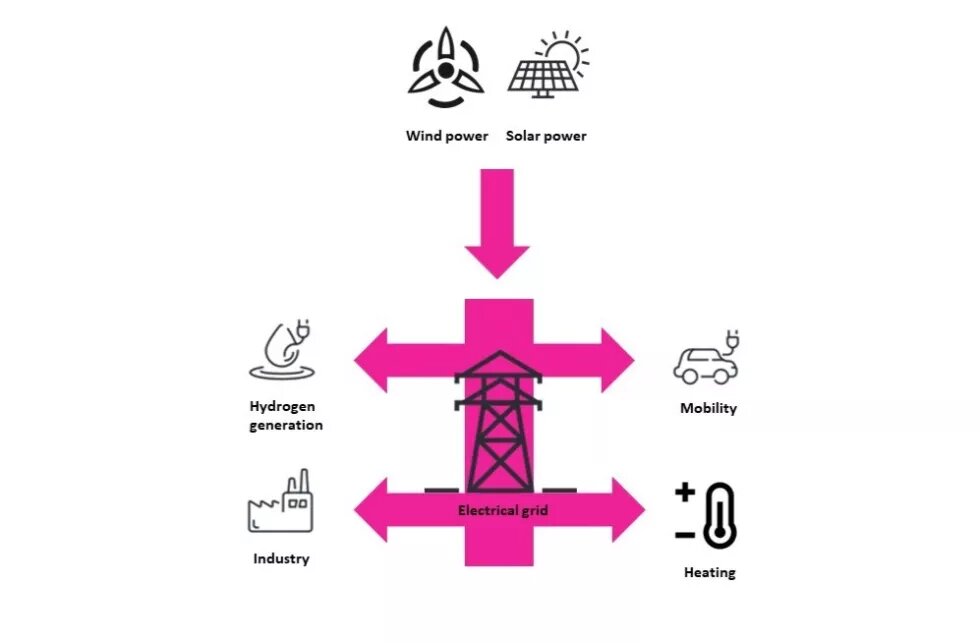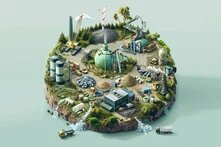
The target vision of zero-carbon emissions presents an enormous challenge to economies around the world and is still not within grasp. How can sector coupling play a significant role in achieving this goal?

What is Sector Coupling?
Sector coupling is a concept that addresses a potential design for the power industry of the future. Traditionally, the energy sectors, i.e. electricity and heat supply, transport and industry, have functioned largely independently from one another. Nevertheless, in the context of the energy transition, which mandates the minimization of fossil fuel use and expansion of the role of renewable energy, and due to the fact that renewable energy is most readily implemented through the electricity sector, a conceptual framework emerged, which entails the integration of the different energy sectors with one another, hence the term “coupling.”
Thus, the concept of sector coupling means that the electricity sector would become the central pillar of the energy system, supplying the other sectors – heat, mobility and industry – with energy in various ways, a scheme described by the term “Power-to-X.” Accordingly, the various sectors would become dependent on electricity production, while they in turn help to solve the problem of the system’s dependence on renewable sources, which by nature are prone to fluctuations.
How does Coupling the Energy Sectors Work?
Historically, there have always been certain links between the energy sectors: Rail transport is partly electric, combined heat and power (CHP) plants generate both electricity and district heating or steam for industrial applications, and electric heating solutions have also been around for a long time. Nevertheless, in the framework of the energy transition, the various energy sectors are becoming significantly more intertwined with one another.
The energy transition began with the intensive expansion of wind and solar power generation, alongside other forms of renewable energy such as the use of biomass and geothermal energy. In many locations around the globe, renewable energy already accounts for a large share of electricity generation. For example, renewable sources provided over 50% of the electricity generated in 2020 in Germany and 37% in the EU overall. However, in recent years it has become increasingly clear that the other energy sectors, i.e. heat, transport and industrial use, pose the greatest challenge for decarbonization efforts. When looking at energy consumption overall – not only for electricity but also for heat, transport, and industrial use – the share of renewables shrinks to 19% for both Germany and the EU.
Indeed, transitioning the energy sub-sectors of heat, transport and industrial use to renewable resources is proving to be a challenging task: Solar thermal energy can only be used for heating to a limited extent since the sun shines the least where and when the demand for heating is the greatest; and biomass, which could be used for transport or industry, cannot be deployed on a large scale without competing with food production, since acreage is limited. It is against this background that electricity, generated from wind and solar, will constitute a main pillar of these energy sectors in the future, linking or coupling them and setting the stage for them to grow together.
The acceleration of sector coupling can be helped with several key technologies and innovative processes. The list below includes some of these technologies and processes, the benefits each can offer as part of the electrification process of the more “stubborn” energy sectors, and the specific challenges that are involved with their integration into the coupling efforts in each sub-energy sector:
- Electric mobility: Electricity can be used in the transportation sector in electric rail transport, but also in electric vehicles that run on batteries. Since cars typically park significantly longer than they are driven, they offer flexibility to accommodate the fluctuations in availability of electricity from renewable energy sources such as solar and wind, which depend on weather conditions. Moreover, they can serve as remote storage units for the electrical system and be discharged to provide electricity when renewable electricity generation is low. However, alongside these advantages, the electrification of transportation faces other significant obstacles and barriers, including high costs, the use of critical resources for battery manufacturing relative to their life cycle, and the dependency on an extensive charging infrastructure;
- Heat pumps: The concept of a heat pump is just the opposite of that of a refrigerator. Electricity is used to transfer heat from one place (soil, water or ambient air) to another (building). The heat yield is about 2-3 times higher than if the same amount of electricity is directly converted into heat. A heat storage system can be integrated, which allows for some deviation between times of electricity use and heat demand, providing the power system with a few hours of flexibility. The main challenge in utilizing heat pumps is that they do not reach temperatures high enough for old buildings, and can therefore mainly be used only in buildings that already energy-efficient;
- Electric heaters: Another form of using power for heat purposes is electric heaters in district heating networks, which can harness generation peaks in renewable electricity that would otherwise overload the grid and therefore need to be curtailed. Electrode boilers are yet another venue for providing heat at high temperature.
- Hydrogen generation: Hydrogen can be produced using electricity through the process of electrolysis (performed by electrolyzing devices known as “electrolyzers”). The hydrogen produced is an emission-free fuel and can be used in multiple ways, e.g. for industrial processes, mobility, heating or electricity generation. Moreover, it has the advantage of being non-fluctuating and controllable in the manner of fossil-fuel plants, obviating the need for energy storage that poses a problem in the case of other green technologies. It is also a main feedstock for synthetic fuels, made from hydrogen and carbon. It can be stored, making it available to run electrolyzers in times of high renewable energy infeed; in addition, it can be used to bridge longer renewable-generation lulls. A main challenge involved in the mainstreaming of hydrogen-based energy is that the electrolyzer industry, which is a key part of the process, is not yet ramping up. A further barrier to integrate hydrogen-based energy concerns the issue of necessary infrastructure that is still not in place, i.e. large-scale network of pipelines, tankers, ports, and requisite auxiliary equipment that is yet to be procured and installed in scale to accommodate the rising need for hydrogen;
- Electrification of industrial processes: There are several industrial processes that currently rely on fossil fuels and that can be electrified. One such example is the process of steel production, where high-temperature heat could be supplied via electricity, or electricity-based hydrogen, instead of natural gas. In combination with electric-arc-furnaces, this process could replace the coal-based blast-furnaces that are currently used for steel production. In addition to enabling reduction in fossil-fuel use for steel production, these new processes also offer economic opportunities for regions with high renewable electricity potentials.
Sector Coupling is Waiting in the Wings
As of 2022, sector coupling technologies are beginning to ramp up. For example, while in 2019, heat pumps accounted for less than 3% of German household heating systems, their share in new buildings was 41%. With respect to the electrification of transportation, the share of electric vehicles in new car registrations in Germany increased eightfold between 2019 and 2021, and now amounts to nearly 14%. In Norway, it was already up to 56% in 2019. Globally, sales of electric cars have doubled from 4% to 8% between 2019 and 2020, driven by subsidy programs and declining battery prices. Smart meters, which are an important prerequisite for harnessing the potential benefits of such distributed flexibility from electric vehicles and heat pumps, are currently being rolled out around the world.
In recent years, industrial companies are increasingly involved in advocating for a clear regulatory framework for industrial decarbonization to future-proof their investments. Some forge ahead, joining alliances such as the “Race To Zero Campaign,” and investing in decarbonized processes.
With respect to hydrogen based-energy, global electrolysis capacity increased by two-thirds to 290 MW between 2017 and 2020. However, this value is significantly lower than the foreseeable electrolysis capacity required; the International Energy Agency expects a worldwide need of nearly 80 million tons of hydrogen from electrolysis in 2030, which would require approximately 80,000 MW of electrolyzers.
What does the Future of Sector Coupling Hold?
The current dynamics might seem promising, however, the target vision of zero emissions presents an enormous challenge to economies around the world and is still not within grasp. If the goals in the Paris Agreements on limiting global warming are to be met, the transition to a zero-carbon economy needs to be significantly accelerated. Sector coupling can play a significant supportive role as part of the energy transition, however, given that it depends on a broad framework of conditions to succeed, it is needed to promote legislation and funding that incentivizes the necessary investments while providing investment security.
FURTHER READINGS
- Robinius, M. et al.: “Linking the Power and Transport Sectors—Part 1: The Principle of Sector Coupling.” Energies 2017, 10, 956, https://doi.org/10.3390/en10070956
- International Renewable Energy Agency (IRENA): “Sector Coupling,” https://www.irena.org/energytransition/Power-Sector-Transformation/Sector-Coupling
- Wietschel et al. “Integration erneuerbarer Energien durch Sektorkopplung: Analyse zu technischen Sektorkopplungsoptionen,” (German), Umweltbundesamt, 2019, https://www.umweltbundesamt.de/sites/default/files/medien/1410/publikationen/2019-03-12_cc_03-2019_sektrokopplung.pdf
- United Nations Framework on Climate Change: “The Paris Agreement,” https://unfccc.int/process-and-meetings/the-paris-agreement/the-paris-agreement
The opinions expressed in this text are solely that of the author/s and do not necessarily reflect the views of hbs Tel Aviv and/or its partners.


